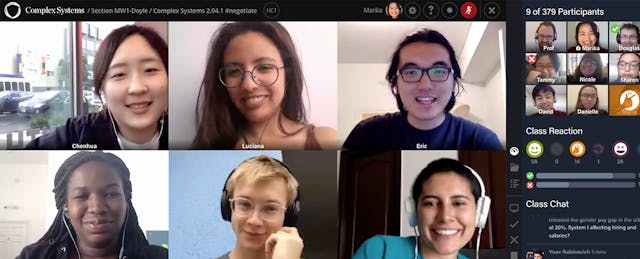An experimental university announced last week that its home-grown online teaching platform can now handle up to 400 students at a time via live video.
The announcement, from The Minerva Project, enters a longstanding debate about whether online education can drastically cut the cost of education by reducing the number of instructors needed to teach. The question is a philosophical one, as some people argue that a theory called Baumol’s cost disease, which states that some labor-intensive sectors do not reduce labor costs even when new technology comes in, explains why the cost of college keeps going up faster than other areas of the economy.
In some ways, the San Francisco-based company is arguing that high-quality education can be done cheaper thanks to technology in ways that have been elusive in the past. And Minerva is not alone, as other colleges these days are trying similar experiments with large-scale live online classes.
Minerva is a for-profit company that has raised more than $119 million since its founding in 2012, and it provides online-education services and curriculum. Its primary customer is the nonprofit university called Minerva Schools at KGI, which aims to offer a selective liberal-arts undergraduate education where classes are fully online, using video and interactive tools.
Minerva’s online-education platform, called Forum, was originally designed for a class size of around 20 people, which is the typical class size at Minerva Schools. The online university advertises its video-based online courses as active-learning seminars, so these class sizes are modeled after their counterparts at many traditional face-to-face colleges.
Over the past year the company has been working to sell its online platform and curriculum to other universities. But Ben Nelson, the Minerva Project’s founder and CEO, says that as it has shopped around its system, it got pushback on the issue of scale. “People said, ‘We’d love to do this, but we can’t afford to teach our students 15 at a time,’” he says. So the company spent the last year trying to retool its system to allow an engaging experience on a larger scale.
Nelson says the new version of the system lets professors quickly divide a large class into groups of up to 12 students. Those break-out groups of students can then participate in a small-group discussion while each student fills out a “structured worksheet” that can be graded later by a TA following a rubric to make sure each student was following along and participating.
During the live class, the professor can peek into any of the breakout sessions, either by appearing as one of the participants, or lurking in the background so that he or she can see and hear the students but they don’t know the professor is there. The requirement of filling out the worksheet, or doing some other activity like a poll or quiz, makes sure students in breakout groups stay on task, Nelson says.
Such a class for 400 students may require very different staffing than a traditional large lecture, he adds. “You may need to have so many TAs that the cost of TAs may exceed the cost of the professor,” he says.
Nelson says the biggest benefit of Minerva’s Forum is that it collects rich data on every interaction taking place within the platform. The system measures how much each student speaks during breakout groups or in class, for instance, and puts them into a dashboard for professors. So when professors are choosing breakout groups, they can pick a mix of talkative and quiet students, or put quiet students together, or have the system group students at random.
Nelson says that one institution set to use the new platform is SRM University AP, Amaravati, in India.
Why cap the system at 400? “It was a very back-of-the-envelope rubric that we used,” he says, largely based on the difficulty of keeping up with grading in a class larger than that.
Notably, though, Minerva Schools at KGI will not be expanding its class sizes. In other words, it will not be taking advantage of this new ability to have hundreds of students in a class.
Why isn’t Minerva’s university putting its new tech into practice?
“Unfortunately, there are all sorts of metrics that have become popularized in the world of higher ed that have little to do with outcomes for students. Class sizes of under 20 is one of those metrics,” Nelson says. “We can’t allow for any would-be critics to be dismissive” because of a belief that students aren’t receiving attention from professors.
Other companies sell software that can support video courses, though Minerva is unusual in that it develops curriculum and software designed to work together.
Live Classes at Scale
MOOCs sparked widespread attention several years ago largely because of excitement over the idea of one professor being able to teach massive numbers of students from across the world at once. Early MOOC experiments had more than 100,000 students per course.
Nelson says that those courses—and others that simply ask students to watch videos and then do automated homework—essentially require no professor at all.
“That doesn’t require a human being,” he says of asking a professor to monitor such a large-scale course. That kind of MOOC should be labeled as adaptive learning, he adds, arguing that “a machine can do better than a professor” in that kind of scenario.
Several universities have gone beyond that model to add live video sessions of their own, especially in for-credit degree programs.
One example is the iMBA program, a low-cost online business program offered by the University of Illinois, run in partnership with Coursera.
Lawrence DeBrock, a dean emeritus and professor of finance at the university who teaches a microeconomics course in the iMBA program, says he leads a live online-video session three times a week. Before each class, students are expected to have already watched the video lectures. During the sessions, they spend the 90 minutes doing hands-on problems based on an event in the news that demonstrates ideas covered in the lectures.

The course takes place over Zoom, a video-conferencing platform, which DeBrock says also allows professors to see data on who speaks and for how long.
“We like to call it the new face to face,” he says of the live video sessions. “If you have a couple hundred people in your live session, I’m seeing 50 or 60 people on the screen, but it rotates through.”
He says there is no upper limit on how many people could attend, though he typically gets between 100 and 150 students for each session. The most he remembers having is 175. But he says there is no upper limit to how many could attend, as long as there were enough TAs monitoring chatroom discussions as students worked out the problems, to correct any misperceptions.
"This is not an operation where one person does it," he says of teaching the live video class. "It takes a team."


